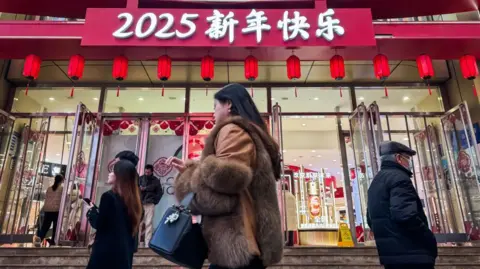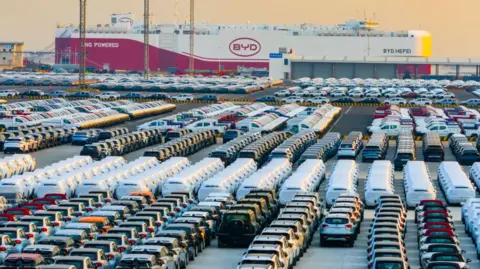Donald Trump’s tariffs aren’t just China’s problem.
 Getty Images
Getty ImagesChina’s economy rebounded in the last three months of last year. Beijing announced on Friday that it will achieve 5% growth by 2024.
But as the world’s second-largest economy struggles to overcome a protracted asset crisis, high local government debt and youth unemployment, it is facing one of its slowest growth rates in decades.
According to the head of the country’s statistics bureau, China’s economic achievements in 2024 were a “hard victory”, after the government launched a number of stimulus measures late last year.
Beijing has rarely missed its growth targets in the past.
Experts have widely predicted this growth rate. The World Bank said that low borrowing costs and increased exports will help China register an annual growth rate of 4.9%.
But investors are bracing themselves: President-elect Donald Trump’s tariffs on $500bn (£409bn) worth of Chinese goods are looming large.
However, that is not the only obstacle to China achieving its growth targets next year.
Business and consumer confidence are low, and China’s yuan continues to weaken as Beijing cuts interest rates to boost growth.
Here are three reasons why Xi has big challenges. Trump’s tariff:
1. Tariffs are already hurting China’s exports.
In the year There is a growing chorus of warnings that China’s economy will shrink by 2025. The main driver of last year’s growth is now at risk – exports.
China has become dependent on manufacturing to get out of the cold snap – so it’s been exporting huge amounts of electric vehicles, 3D printers and industrial robots.
The US, Canada and the European Union accuse China of making too many goods and slap tariffs on Chinese imports to protect local jobs and businesses.
Chinese exporters may now turn their attention to other parts of the world, experts say. But those countries may be in emerging markets that don’t have the same level of demand as North America and Europe.
That could hit Chinese businesses hoping to expand, and in turn energy and raw material suppliers.
Xi wants to transform China from a factory producing cheap goods to a high-tech powerhouse by 2035, but it’s unclear how manufacturing will continue to be a major driver of growth amid rising tariffs.
2. People are not spending enough.
In China, family wealth is mostly invested in the property market. Before the real estate crisis, it accounted for a third of China’s economy — employing millions of people, from builders and developers to cement manufacturers and interior designers.
Beijing has implemented a number of policies to stabilize the property market and the financial markets watchdog, the China Securities Regulatory Commission (CSRC), has announced that it will strongly support reforms.
But there are still too many vacant homes and commercial properties, and that oversupply continues to keep prices down.
 Getty Images
Getty ImagesThe property market slump is expected to ease this year, but Wall Street banking giant Goldman Sachs said the slowdown would be a “multi-year drag” on China’s economic growth.
Household consumption accounted for 29 percent of China’s economic activity in the last three months of 2024, down from 59 percent before the pandemic.
This is one of the reasons why Beijing has strengthened its exports. It wants to help offset slower domestic spending on new cars, luxury goods, and just about everything else.
Even the government has introduced such programs Marketing of consumer goodsWhere people exchange their washing machines, microwaves and rice cookers.
But experts wonder whether such measures alone are enough without addressing deeper issues in the economy.
They say people need more cash in their pockets before the pre-Covid phase to get cash back.
“China needs to bring back the animal spirit of its people and we are still a long way from that,” said Shung Ding, chief economist for Greater China and North Asia at Standard Chartered Bank.
“If the private sector starts investing and creating innovation that can increase income and job prospects, people will have more confidence to use it.”
High public debt and unemployment have affected savings and spending.
Official figures suggest Youth unemployment rate It’s higher than it was before the pandemic, and wage growth has stalled.
3. Businesses are not flocking to China like before
President Xi has pledged to invest in what the government calls “new productive forces” in modern industries.
So far, this has helped China become a leader in renewable energy products such as solar panels and electric vehicle batteries.
Last year, China also surpassed Japan as the world’s largest car exporter.
 Getty Images
Getty ImagesBut a lackluster economic picture, uncertainty over tariffs and other geopolitical uncertainties mean that foreign businesses have waned to invest in China.
It’s not about foreign or domestic investment — it’s that businesses don’t see a bright future, said Stephanie Ling of wealth management platform Stash Away.
“They want to see a diverse set of investors come in.”
For all these reasons, experts believe that the measures taken to support the economy will partially reduce the potential impact New American tariffs.
“We expect them to choose the former,” wrote Hui Shan, Goldman Sachs’ chief China economist, in a recent report.
“China needs to stabilize property markets and create enough jobs to ensure social stability,” said Mr Ding from Standard Chartered Bank.
As a researcher of China Descent Monitor More than 900 protests have been held in China. Between June and September 2024, led by workers and property owners – a 27% increase compared to the same period a year ago.
Due to economic grievances and resource erosion, such social problems become a threat to the Chinese Communist Party.
After all, explosive growth has turned China into a global power, and the promise of prosperity has helped its leaders win over the opposition.


